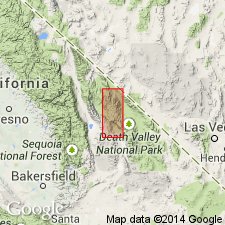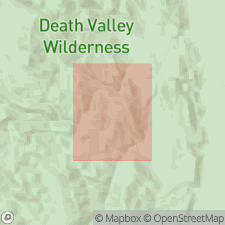
- Usage in publication:
-
- Stone Canyon Formation*
- Modifications:
-
- Original reference
- Biostratigraphic dating
- Dominant lithology:
-
- Limestone
- Chert
- AAPG geologic province:
-
- Great Basin province
Summary:
Pg. J5 (fig. 3), J7-J8 (fig. 4), J15-J17, J38. Stone Canyon Formation. Thinly interbedded, dark-gray, cherty limestone, chert, and mostly silicified micrite beds. Thickness 107 to 456 m. Overlies Tin Mountain Limestone; underlies Santa Rosa Hills Limestone. Present in southeastern-facies belt (carbonate platform), notably the Santa Rosa Hills area, eastern Inyo County, eastern California. Rocks previously included in Perdido Formation by some geologists. Age is late Early Mississippian (Osagean; Lower TYPICUS to MEHLI-Lower TEXANUS conodont zone of Poole and Sandberg, 1991; Mamet foraminiferal zones 7-12).
Type section: near Minnietta Mine along east flank of Argus Range, approx. 500 m north of Stone Canyon, between 3,120 and 3,440 ft elevation, in secs. 27 and 28, T. 19 S., R. 42 E., Lat. 36 deg. 15 min. 13 sec. N., Long. 117 deg. 26 min. 28 sec. W., Panamint Butte 15-min quadrangle, Inyo Co., eastern CA. Named from Stone Canyon. (Rocks previously mapped as Perdido Formation by Hall, USGS Bull. 1299, 1971.)
Reference section: in Cottonwood Canyon, Cottonwood Mountains, in sec. 8, T. 16 S., R. 43 E. (unsurveyed), [Lat. 36 deg. 34.8 min. N., Long. 117 deg. 19.2 min. W.], Cottonwood Canyon quadrangle, Inyo Co., Death Valley National Monument, eastern CA (this is Cottonwood Canyon section of Stevens and others, 1995, SEPM Spec. Pub., no. 52).
Source: Publication.

- Usage in publication:
-
- Stone Canyon Limestone*
- Modifications:
-
- Age modified
- AAPG geologic province:
-
- Great Basin province
Summary:
Pg. 5-6, 39-40, geol. map. Stone Canyon Limestone. Cherty limestone, 417 m thick. Underlies Santa Rosa Limestone; overlies Tin Mountain Limestone. Fossils. [Due to changes in the geologic time scale], age is late Early to Middle Mississippian (Tournaisian to Visean; Osagean) based on conodonts, citing Stevens and others, 1996.
Source: Publication.
For more information, please contact Nancy Stamm, Geologic Names Committee Secretary.
Asterisk (*) indicates published by U.S. Geological Survey authors.
"No current usage" (†) implies that a name has been abandoned or has fallen into disuse. Former usage and, if known, replacement name given in parentheses ( ).
Slash (/) indicates name conflicts with nomenclatural guidelines (CSN, 1933; ACSN, 1961, 1970; NACSN, 1983, 2005, 2021). May be explained within brackets ([ ]).

